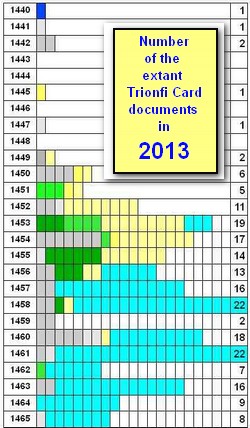Ser Giovanni Bandini (active 1451), the first common User
composed by Lothar Teikemeier, last update 06.12.2012
|
Sources
Source is taken from Franco Pratesi's new article series written from November 2011 till now, published here at Trionfi.com.| SOURCE 1: Ser Giovanni Bandini 1451 |
|
Quote from Franco Pratesi: "1451 – one common Pack of Trionfi", 15.09.2012 |
1.4 One Family - BandiniBandini is a rather common family name in Florence. In the phone directory for 2011/12 we can count no less than ninety entries at this name. If we go back in time for sixty years, one of my dozen friends of the school-days had this family name. We have however to go farther, towards even earlier times. Searching in “Dizionario biografico degli Italiani”, we still find a score of personages belonging to this family.(6) 1.5 One Author – Ser Giovanni BandiniThe person of our interest is precisely Ser Giovanni Bandini di Ser Lorenzo di Ser Agnolo. The profession of notary had seemingly an almost hereditary character in this family: as a matter of fact, both Giovanni’s father and grandfather were named with the typical Ser label. |
|
Repeated Note: When Ross Caldwell and me in 2003 started to collect Trionfi notes between 1442-1463, we had about 27/28 entries (which I nowadays would count as 31). The major part were the documents of Ferrara, which were collected by Gherardo Ortalli and Adriano Franceschini in the "Prince and the Playing Cards" (1996), after the base laying works of Michael Dummett and Stuart Kaplan around 1980. This collection included 2 notes about Trionfi cards in Florence, found by Franco Pratesi in his earlier work (allowances of the Trionfi game in 1450 and 1463). A graphical representation of this time (with 27 entries) shows the dominance of Ferrarese documents (in black) with a few notes only from other locations (in red; see picture to the right) In the period 2004 till October 2011 it was possible to add 4 further notes (Siena 1452, Padova 1455, Ancona c. 1460 and Valerio Marcello c. 1460), mainly thanks to information given by Thierry Depaulis. Franco Pratesi started his new article series in November 2011. Since then the list has gotten 67 new documents till September 2012 (65 of them found by Franco Pratesi, one, now the oldest of September 1440, by Thierry Depaulis, and another one by Veber Gulinelli, who controlled the earlier work of Franceschini and found an overlooked document) and nearly all are related to Florence or its surrounding. A small book (118 pages) was published around Christmas 2012, Franco Pratesi: "Playing Card Trade in 15th Century Florence" as IPCS Paper No. 7 (ISSN 0305-2133). It contains some of the articles, which before had appeared at this website, those, which treat the early time of 15th century. Thierry Depaulis commented in his foreword: "This book is a landmark in the history of early playing cards in Italy". Well, maybe not the book, but the research is clearly a landmark in various interests. For the collection of early Trionfi notes it somehow means, that we have within the year 2012 about 200 % more data for the period 1440-1462 than mankind had collected in the 200 years before. Added later: In August 2013 the new report of Arnold und Doris Esch: "Aus der Frühgeschichte der Spielkarte. Der Import von carte da giocare und trionfi nach Rom." in Gutenberg Jahrbuch 2013, 88. Jahrgang, p. 41-53, arrived in our redaction. It contains 106 new references to Trionfi decks, which all were found in the customs registers of the city Rome for the period 1453-1465. With this the number of all earlier Trionfi cards records has been doubled and should have reached then c. 210 (from which a few are only considered to be "Trionfi card notes" and don't contain the word "Trionfi" or something similar). *********** I'd started to sort the new Trionfi card documents overview in October 2012. Articles will be possibly changed according improvements in research. |
|

- Start / Content
- Old Trionfi Notes Collection of Trionfi.com
- Franco Pratesi's article collection 2011/12
- Franco Pratesi's article collection 2012/13
Trionfi Card Persons 1440-1462
Overview- Trionfi Dates Collection
- Early Playing Card Producers Florence
- List of early "Expensive Decks"
- Collection of Purchasers
---- Old Material - Documentation: Old Summary of 2003
- Old Lists (till c. 2009)
- References of Documents (old list c. 2003)
- Further Persons in Trionfi Documents (old list c. 2003)
- New Input to the list in 2011 - 2012 (in work)
Commissioners (Trionfi cards)
- Filippo Maria Visconti, duke of Milan (in work)
- Leonello d'Este, Signore of Ferrara (in work)
- Borso d'Este, Signore of Ferrara, duke of Reggio and Modena (in work)
- Francesco Sforza / Bianca Maria Visconti, duke and duchessa of Milan (in work)
- Giusto Giusto, oldest Trionfi note 1440 (in work)
Ferrara: Artists and Card Producers (Trionfi cards)
- Iacopo Sagramoro
- Gherardo da Vicenza
- Domenego dicto Don Messore, Giovanni di Lazzaro, Bartolomeo Cartesana
- Petrecino, page of Borso
- Anselmo Selimbeni, got printing material for Trionfi cards
Ferrara: Traders
Florence: Artists and Card Producers (Trionfi cards and mostly also playing cards)
- Antonio di Dino
- Matteo Ballerini
- Giovanni di Domenico
- Manetto Agnolo merciai
- "Paparello" - alias Iacopo di Poggino di Luca (1398-1481)
- "Lo Scheggia" - alias Giovanni di Ser Giovanni (1406-1486) (in work)
- Filippo di Marco
- Benedetto di Antonio Spigliati, helper of Filippo di Marco
- "Giovanni dal Ponte" - alias Giovanni di Marco (1385 - 1437/42) (in work)
- "Andrea da Castagno" - alias Giovanni di Marco (c. 1421 1457) (in work)
- Various Suppliers of the Silk Dealers
Florence: Artists and Card Producers (normal Playing Cards)
- Niccolò di Calvello
- Antonio di Simone
- Various Florentine Playing Card Suppliers
Florence: Trade with Trionfi and Playing Cards
- Lapini family (1415-1422 and 1453-1454)
- Ser Andrea di Giovanni Bertelli in Prato (1429-1431)
- Silk dealer Lorenzo di Bartolo and Matteo di Zanobi (1431-1460) (in work)
- Puri family (1447-1449)
- Giovanni da Pistoia, import to Rome (1453)
- Bartolomeo di Paholo Serragli (1453-1458), cards for rich persons (in work)
- Andrea Banchi, export of various articles to Rome (1456)
- Cambini family, 96 Trionfi decks for Venice (1462)
- List of Purchasers
Users of Playing Cards
Special events

